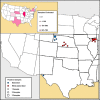Detection of chronic wasting disease in the lymph nodes of free-ranging cervids by real-time quaking-induced conversion
- PMID: 24958799
- PMCID: PMC4313144
- DOI: 10.1128/JCM.01258-14
Detection of chronic wasting disease in the lymph nodes of free-ranging cervids by real-time quaking-induced conversion
Abstract
Chronic wasting disease (CWD), a transmissible spongiform encephalopathy of deer, elk, and moose, is the only prion disease affecting free-ranging animals. Since the disease was first identified in northern Colorado and southern Wyoming in 1967, new epidemic foci of the disease have been identified in 20 additional states, as well as two Canadian provinces and the Republic of South Korea. Identification of CWD-affected animals currently requires postmortem analysis of brain or lymphoid tissues using immunohistochemistry (IHC) or an enzyme-linked immunosorbent assay (ELISA), with no practical way to evaluate potential strain types or to investigate the epidemiology of existing or novel foci of disease. Using a standardized real-time (RT)-quaking-induced conversion (QuIC) assay, a seeded amplification assay employing recombinant prion protein as a conversion substrate and thioflavin T (ThT) as an amyloid-binding fluorophore, we analyzed, in a blinded manner, 1,243 retropharyngeal lymph node samples from white-tailed deer, mule deer, and moose, collected in the field from areas with current or historic CWD endemicity. RT-QuIC results were then compared with those obtained by conventional IHC and ELISA, and amplification metrics using ThT and thioflavin S were examined in relation to the clinical history of the sampled deer. The results indicate that RT-QuIC is useful for both identifying CWD-infected animals and facilitating epidemiological studies in areas in which CWD is endemic or not endemic.
Copyright © 2014, American Society for Microbiology. All Rights Reserved.
Figures




References
-
- Williams ES, Miller MW, Kreeger TJ, Kahn RH, Thorne ET. 2002. Chronic wasting disease of deer and elk: a review with recommendations for management. J. Wildl. Manage. 66:551–563. 10.2307/3803123. - DOI
Publication types
MeSH terms
Substances
Grants and funding
LinkOut - more resources
Full Text Sources
Other Literature Sources
Medical

